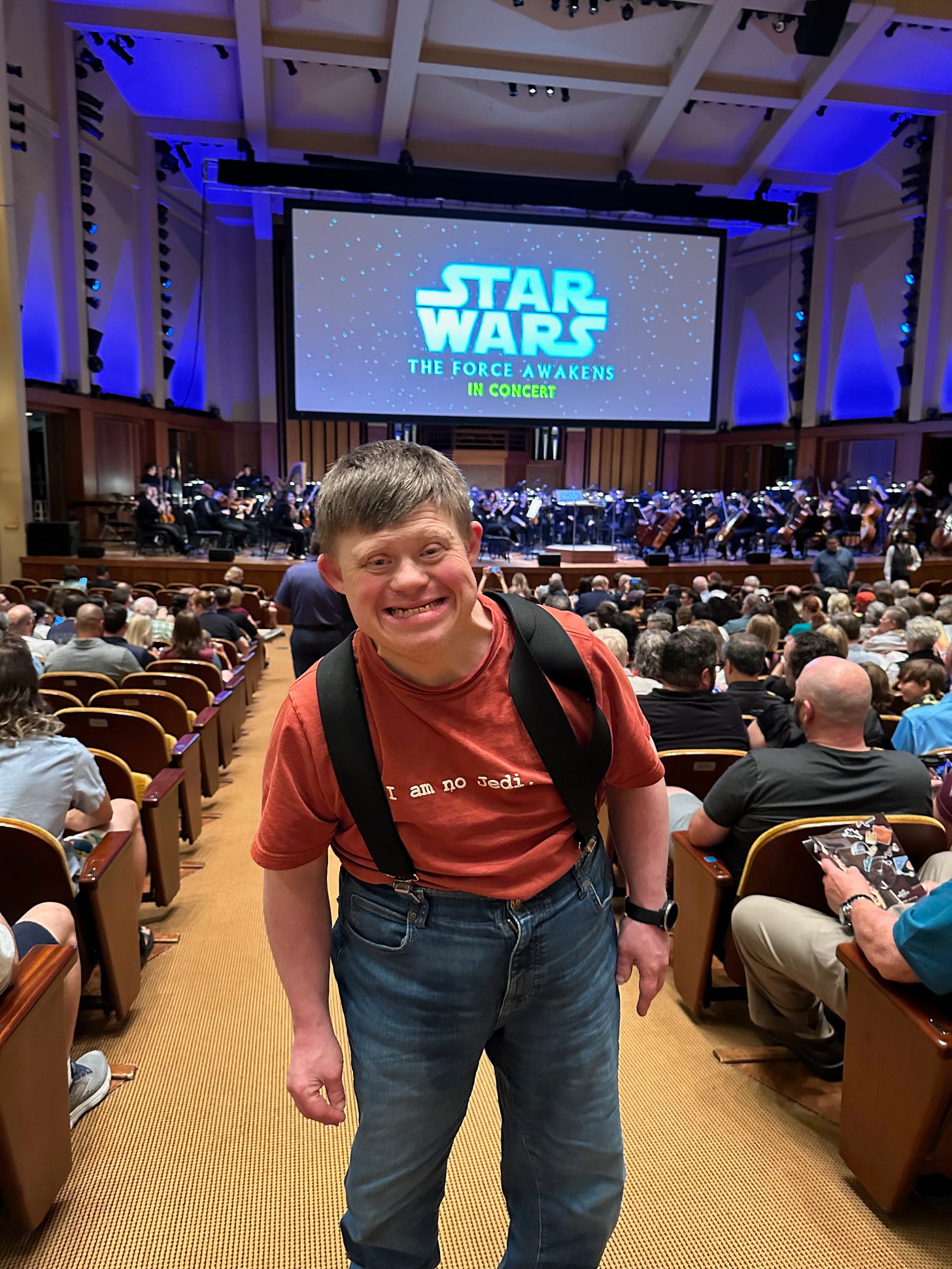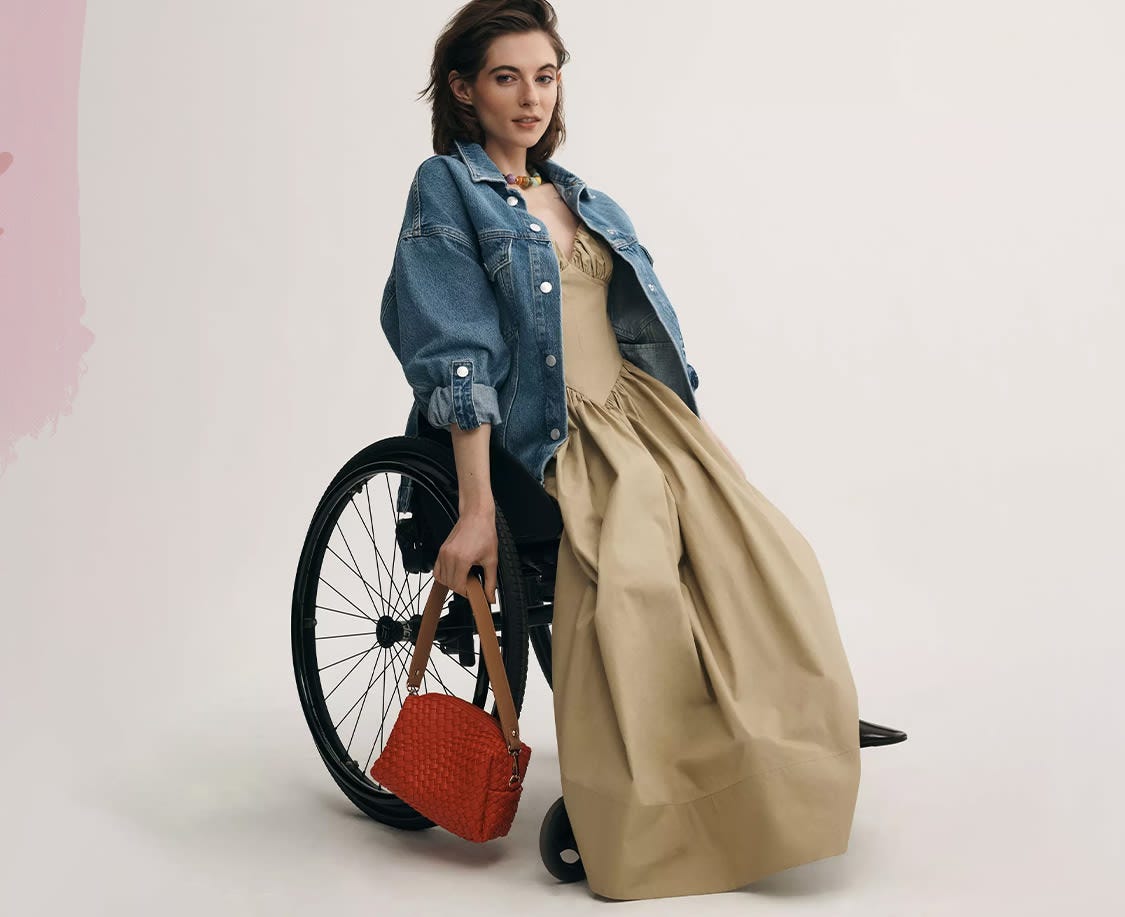The Limits of Being Seen
What my brother with Down syndrome taught me about true representation

Forty-nine years ago in a sterile hospital room, my mother was urged to surrender her newborn son with Down Syndrome to an institution. Today I scroll Instagram and see moms of smiling babies with Downs and tens of thousands of followers gushing over how cute they are. These two scenes demonstrate progress, but also pretense.
While giving up Down Syndrome babies is what many people did prior to the 1980s, my mom did not even consider giving Leif up. In fact she was so incensed that the doctors would suggest such a thing that when it was time for my birth a few years later, she drove to a hospital in another town rather than returning to the same. As a result my brother has had a family to advocate for his care, access to special education, went on trips and was socially integrated. As an adult he lives in his own apartment with 24 hour staff available, balancing his independence with care needs.
Raising Leif certainly wasn’t easy. Though he passed many of the milestones that the doctors claimed he never would, he has also remained very high needs his entire life. Much of my childhood was built around his needs - constant health challenges, surgeries and mood and social emotional plights. As an adult, taking over his guardianship as the only remaining family member involved has been a big responsibility.
As hard as it has been for him and our family, he has had the opportunity to live the best life he can with significant disabilities. I truly believe that I have also learned and gained so much from having Leif as a brother. As a child, I learned empathy and acceptance early on, and was always a staunch defender of my brother and any other kids who were different. I know the experience has built my empathy, resilience, ability to care for my kids, and my view on life and its beauty and challenges.
Attitudes toward people with Downs have changed a lot since we were kids. They are no longer boxed into an out-of-date stereotype about (lack of) ability, and are much more represented in media and in public. I see people with Downs Syndrome in the Peloton cycling studio when I take the classes on demand at home. A powerful ad last year featured an incredible actor with Downs imploring us to “Assume that She Can.”
Not surprisingly I have a soft spot for Downs representation; it makes me smile and reflect on how, in many ways, we’ve come a long way toward being inclusive as a society. But I’m also often reminded of how far we still have to go - especially now.
Representation still feels so very cherry-picked and fickle. Every person with Down Syndrome I see represented in public spaces is significantly higher functioning than my brother, for example. And always happy. Those same Instagram influencers who show off their babies with Downs often glorify (high functioning) downs syndrome without acknowledging that it is, in fact, a disability that comes with serious hardships and complications.1 And the hard stuff is really important to acknowledge - the hard stuff is what makes caregivers feel truly alone, and seeing others going through it is what builds empathy, acceptance and resilience.
In fashion, representation often feels performative - plus sized models and adaptive clothing lines come to mind. The adaptive clothing line released by Anthropologie last year featured a woman in a wheelchair wearing a long, bulky dress that hangs down to the ground. Comments from wheelchair users immediately pointed out that it was ridiculously impractical and posed safety issues since the dress would easily get caught in the wheels. “But look, we are inclusive!!”
I think this problem is true of many forms of representation - they are limited to what we still feel are within acceptable “difference” comfort levels. We want representation, but inside the boundaries of what we find attractive or relatable. We want diversity, as long as it’s cute and still part of the “other” category. I think this highlights areas where we aren’t truly cognitively there yet when it comes to inclusion, even when we think we are, or we want to be.
Right now the country’s comfort level with difference seems to be at an all time low. We have a president who has publicly mocked disabled people, and that has built an entire platform upon hate at division. Aside from the basic human kindness and moral arguments for inclusion, plenty of research shows that diversity and inclusion are objectively good for business in many ways, from profits to innovation and employee satisfaction and retention.2 Yet just like that, with the recent executive orders that vilify DEI, many companies flipped with the tide and cancelled their previous commitments to representation and inclusion.3
Diversity and inclusion isn’t only about hiring, or about people of color, or about seeing people that look different represented. Acknowledging and integrating diversity is essential to caregivers - it why we have things like wheelchair ramps, accessible bathrooms, breastfeeding rooms, ergonomic workspaces, subtitles - even forks at Chinese restaurants are an inclusion initiative. Yet somehow the idea of minimizing or leveling unearned advantages is still incredibly threatening to so many.
Everyone deserves to see themselves out in public, in the media, in leadership, in clothing - represented. But representation is just the beginning. Many differences aren’t even representable in a visual way, and its not just visible differences that exist and matter.4 You aren’t going to open minds while bombarding people with images that all look the same. Visual representation is critical to opening minds, but we also need more open minds to properly create representative images and spaces, and ensure that they way we interpret them doesn’t immediately lead to stereotyping.
Its much easier to “check the box” with the type of representation that is most closely linked to the existing norm. Achieving the actual full range of inclusivity requires a much more difficult cultural shift and enlightenment around our own biases. It requires constantly pushing comfortable boundaries, exposure to new things, and education along with the box-ticking of representation.
One visit to the summer picnic or holiday party with the organization that handles my brother’s care will open anyone’s eyes to a fuller range of diversity than you regularly see in your own daily life or on instagram. If you ever want an invite, we would love to have you, and you will most certainly be included.
How does inclusivity become a real value that is ingrained in community, company, cultural values, versus simply performance that echos the evolving chant of the crowd?
What do you think are the most important steps to building societies and cultures that inherently value inclusivity and diversity, and understand the benefits to everyone?
Please engage in the comments!
I’ve noticed they often use their platform to push a pro-natalist, anti-choice agenda, which is problematic on many levels.
See Gartner, Mckinsey, Pew Research, among others.
Never mind that the EOs don’t even apply to private companies.
I will say that I’ve been impressed by the increase in adaptive environments offered, particularly for people on the autism spectrum or with sensory differences, here in Seattle. There are usually noise muffling headphones readily available at schools and event venues, and often sensory-aware performances, events and rooms available.








I hear you, Anna. I agree very much with this...
Visual representation is critical to opening minds, but we also need more open minds to properly create representative images and spaces, and ensure that they way we interpret them doesn’t immediately lead to stereotyping.
In addition, to more open minds creating and producing, we could each think more about HOW we consume information. Empower ourselves to question & critical think what we see, triangulate information.
as you say 'It requires constantly pushing comfortable boundaries, exposure to new things, and education along with the box-ticking of representation.'
Where and how we get our information/images can create a preset filter.
Things like Clickbait news, the Attention economy, social conditioning, echo chambers, and unconscious bias are just some things that can confound, or at worst blinker, many people now that information is faster and more omnichannelled for different work/personal use!
Thanks! Another absorbing article. Say Hi to Leif - I've a little concert envy. The John Williams documentary on Netflix is great!